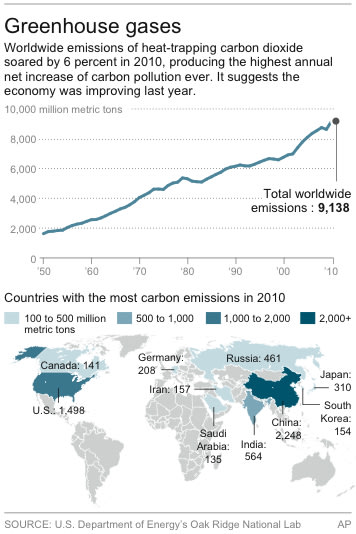Seth Borenstein of the Associated Press reports — and editorializes — on the grim news:
The global output of heat-trapping carbon dioxide jumped by the biggest amount on record, the U.S. Department of Energy calculated, a sign of how feeble the world’s efforts are at slowing man-made global warming.
Feeble indeed. You go, Seth. You’re an honorary blogger now!
The new figures for 2010 mean that levels of greenhouse gases are higher than the worst case scenario outlined by climate experts just four years ago.
That means worse than the A1FI scenario (1000 ppm). It means 10F warming (this century) give or take — and multiple, simultaneous catastrophes.
Here are more details of the sorry situation we find ourselves in:
CLICK HERE TO READ MORE OR COMMENT
The world pumped about 564 million more tons (512 million metric tons) of carbon into the air in 2010 than it did in 2009. That’s an increase of 6 percent. That amount of extra pollution eclipses the individual emissions of all but three countries — China, the United States and India, the world’s top producers of greenhouse gases.
It is a “monster” increase that is unheard of, said Gregg Marland, a professor of geology at Appalachian State University, who has helped calculate Department of Energy figures in the past.
Extra pollution in China and the U.S. account for more than half the increase in emissions last year, Marland said.
Chinese emissions now exceed ours by a whopping 50%. They will be double ours by 2020 if they keep on their rapacious, immoral path of weekly coal-plant building — and we keep on our rapacious, immoral path of doing nothing.
“It’s a big jump,” said Tom Boden, director of the Energy Department’s Carbon Dioxide Information Analysis Center at Oak Ridge National Lab. “From an emissions standpoint, the global financial crisis seems to be over.”
… India and China are huge users of coal. Burning coal is the biggest carbon source worldwide and emissions from that jumped nearly 8 percent in 2010.
In 2007, when the Intergovernmental Panel on Climate Change issued its last large report on global warming, it used different scenarios for carbon dioxide pollution and said the rate of warming would be based on the rate of pollution. Boden said the latest figures put global emissions higher than the worst case projections from the climate panel. Those forecast global temperatures rising between 4 and 11 degrees Fahrenheit by the end of the century with the best estimate at 7.5 degrees.
Even though global warming skeptics have attacked the climate change panel as being too alarmist, scientists have generally found their predictions too conservative, Reilly said. He said his university worked on emissions scenarios, their likelihood, and what would happen. The IPCC’s worst case scenario was only about in the middle of what MIT calculated are likely scenarios.
You can read about MIT’s projection here: “M.I.T. doubles its 2095 warming projection to 10°F — with 866 ppm and Arctic warming of 20°F.” MIT attempts to model more realistic emissions and some of the many, many, many amplifying feedbacks.
Chris Field of Stanford University, head of one of the IPCC’s working groups, said the panel’s emissions scenarios are intended to be more accurate in the long term and are less so in earlier years. He said the question now among scientists is whether the future is the panel’s worst case scenario “or something more extreme.”
“Really dismaying,” Granger Morgan, head of the engineering and public policy department at Carnegie Mellon University, said of the new figures. “We are building up a horrible legacy for our children and grandchildren.”
But Reilly and University of Victoria climate scientist Andrew Weaver found something good in recent emissions figures. The developed countries that ratified the 1997 Kyoto Protocol greenhouse gas limiting treaty have reduced their emissions overall since then and have achieved their goals of cutting emissions to about 8 percent below 1990 levels. The U.S. did not ratify the agreement.
Yeah, I know, the climate pragmatists say treaties don’t work — only waiting for miracles works. Go figure.
Related Post:





No comments:
Post a Comment